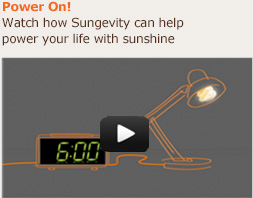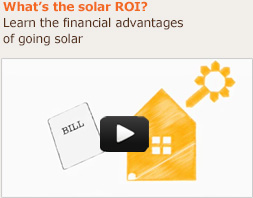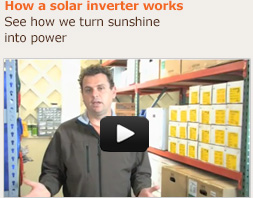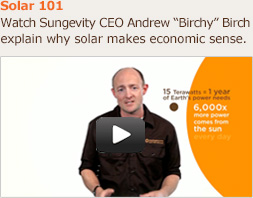Go solar. Save money. Be happy
Find out how easy — and even fun — it is to power your life with clean, green solar power from Sungevity.
Solar glossary
There are a lot of terms specific to the home solar industry. Some you may already know and others may
be new to you. Below are the definitions for several commonly used technical terms:
- Balance of system
The balance of system includes racking for the solar panels, roof integration equipment, wiring and conduit. Just add panels and an inverter and you've got a home solar system!
- Batteries
Batteries aren't needed with a grid-tied system as the grid itself serves the purpose of providing electricity when your rooftop solar isn't producing power. All those credits you accumulate when the sun is shining help pay down or completely negate the cost of electricity you utilize at night or on a cloudy day!
- FICO score
FICO is Fair, Isaac and Company, and it's a method of calculating your credit score. There are three credit reporting agencies — Experian, TransUnion and Equifax. FICO is one method of calculating your score based on the information held by each credit agency. There are additional methods for calculating unofficial scores such as PLUS, Vantage and others, but they are only for informational purposes and do not count as official credit reports that can be used by banks, car dealerships or other financial institutions. Think of these different scoring systems like MILES (FICO) and KILOMETERS (all others). When a bank needs your credit score, they need miles, which would be FICO. Sungevity runs a FICO check for Experian, and we need a 700 FICO credit score. Other scoring systems like PLUS and Vantage will not be accepted.
- Interconnection
Interconnection is the point at which your solar system is connected to the electricity grid. The utility needs to give you permission to operate your power generator and "interconnect" it to their system. Sungevity will complete all the necessary paperwork to get your system up and running.
- Kilowatt hour
A kilowatt-hour (kWh) is a unit of energy equal to 1000 watt-hours. If you left ten 100W light bulbs on for one hour, you would use 1 kWh of energy (though we know your house is full of compact flourescent bulbs!). Electric utilities bill customers in kWh.
- Module power ratings
To help standardize measurement of a solar panel's power output, several government rating agencies created power rating standards. The most common ratings are STC-DC and CEC-AC. It's a little confusing because both ratings are widely used, often together and each measures the solar panel output in a slightly different way. STC-DC (Standard Test Condition Direct Current) rating measures a panel's output in ideal laboratory test conditions and is the standard global power rating for solar panels. CEC-AC (California Energy Commission Alternating Current) rating measures panel's output in real life production conditions and factors in the inverter's efficiency of converting DC to AC. The CEC-AC is always lower than the STC-DC rating, because it takes account of inefficiencies throughout the balance of the solar system.
- Net metering
When you install a grid-tied solar system, your utility monitors how much electricity your solar panels produce and how much electricity you use through a process known as net metering. If your home solar system generates more electricity than you use, you export it to the grid and receive credit from your utility. When you use more electricity than you generate, like at night, you draw it back off the grid as required. Your utility determines the difference between the electricity you generate and what you use from the grid, and bills you for that difference. Because the amount of power you'll generate is greater during the summer than in the winter, this balance is reconciled at the end of each year.
If, at the end of the year, you have produced more than you used, some utilities will compensate you for this extra power but others will not. Contact your utility for up-to-date information about their net metering or solar bank program.
- PACE
PACE stands for Property Assessed Clean Energy. Many municipalities are setting up PACE programs that help their residents finance a solar system by paying it off through the annual property tax bill. The relatively high interest rate for most PACE programs typically makes PACE financing less cost-effective than a Sungevity Solar Lease. It may, however, be a good option for people who do not live in Sungevity's service area. Please note that as of the summer of 2010, legal complications are interfering with the rollout of most PACE programs.
- PPA
A PPA (Power Purchase Agreement) means you buy the energy that comes out of the system one kWh at a time and you have to buy all of it, so your payment changes each month. Think of this like renting a car PER MILE. Our lease is more like renting a car at a FLAT-RATE per day. You pay a fixed amount. And if the system produces more power than we thought, you get to keep it with no extra charge. A lease is better for the customer because your payment is more predictable. A PPA is better for the financing company because they don't have to give away any power for free.
- Prepaid lease
You pay 20 years of leasing in advance at a discount. Much cheaper than a purchase, you still get the system for 20 years, and we warranty everything bumper to bumper! Most customers who were originally looking at a purchase find the prepaid lease to be a much better deal. Basically hedging your energy costs, just like when Southwest Airlines® bought a bunch of jet fuel in advance and ended up saving themselves a ton of money.
- Solar inverter
The solar inverter is the electrical box that turns direct current (DC) electricity produced by solar panels into alternating current (AC) electricity. A grid-tied solar inverter allows this AC electricity to be sent back to the grid when you produce more energy than you use.
- Solar lease
A Solar Lease is a legal agreement between you and Sungevity that specifies the size of the system Sungevity will install and maintain as well as the monthly amount you will pay Sungevity. A Sungevity Solar Lease comes with a performance guarantee that promises the panels will produce the power agreed to in the contract. And, any power generated above and beyond the guaranteed amount is yours to keep!
- Solar panels
Also called solar modules, solar panels are made up of silicon "cells" that absorb photons (sunlight) to create a photovoltaic (PV) effect that allows for the conversion of sunlight to electricity. (Silicon just happens to be the Earth's most abundant element other than oxygen and is also used to make computer chips, glass and cement.) Solar panels are linked together to form "strings" and strings are combined to form "arrays." This array is connected to your home via an inverter, delivering electricity to power your home — or back to the grid, if your system produces more electricity than you use.
- The grid
The grid is a network of powerlines that carries and transmits electricity from large centralized power plants to individual homes. The term "going off the grid" refers to a household that generates all of its own power and no longer relies on the grid. Sungevity systems are "grid-tied" (or connected to the grid) so you can still power your house when the sun doesn't shine and can take advantage of all the tax incentives, as well as state and municipal rebates that are available for grid-tied systems.
- Utility
Depending on where you live, you get your power from a local municipality (e.g., SMUD: Sacramento Municipal Utility District) or from a large power producer (e.g., PG&E;: Pacific Gas & Electric Company). Utilities produce power and send it to you via the grid.
FAQs
Get answers to the most commonly asked questions about Sungevity
Sungevity’s Solar Energy Plan
We believe that Sungevity solar energy plans makes solar affordable. Many homeowners who want the benefits of solar energy can't afford the upfront cost associated with a cash system, so with a solar energy plan, we make the upfront investment and absorb all the burdens and risks. We pay for the design and installation and are responsible for the system's operation, maintenance, repair and monitoring. Customers get solar electricity with locked in price-stability. You can go solar with no down payment and you'll save money from Day 1. With a Sungevity solar energy plan, the reduction in your monthly energy bill will usually be greater than your solar energy plan payment and on top of the financial benefits, provide proactive monitoring and maintenance, and insure your system against accidental damage.
Sungevity solar energy plans are a 20 year commitment to solar-powered living and financial savings.
You may end up selling your home so we make it easy to transfer your solar energy plan to a new homeowner. You have several options which are explained in your account documentation, including: 1. Assigning your energy plan to the new homeowner subject to credit check. 2. Prepaying the remaining payments and assigning the benefits and non-financial obligations (e.g., roof access) to the new homeowner. 3. Purchasing the Sungevity solar home system at fair market value. 4. Terminating the solar energy plan and asking us to remove the system. All of these details are set forth in your Sungevity agreement documentation, including applicable renewable energy incentive holding periods and recapture payments.
Your historical energy consumption is necessary to customize a solar solution that matches your lifestyle, current and future. Having it makes our solar iQuote accurate and best predicts the money we can save you by going solar. We also need 12 months' historical energy consumption for completion of solar rebates and incentive paperwork.
Your Sungevity solar energy plan lasts 20 years. At the end of the agreement, we make it easy for you to continue with solar, or to have us remove the system.
Sungevity
Sungevity's service area is growing fast. We currently serve most parts of California, Colorado, Connecticut, Arizona, Massachusetts, New York, New Jersey, Maryland, and Delaware.
We offer a number of affordable payment options, including a $0 money down solar lease, a pre-paid lease, fixed payment lease, and a Power Purchase Agreement (PPA). We can also help you finance a solar system with a home equity loan (HELOC). Request your free solar iQuote at www.sungevity.com/get-your-iquote to learn whether solar is right for you. After we've consulted with you about your current (and future) energy use, we use our remote proprietary design tool to engineer a custom solar solution for your home. We then complete all of the paperwork on your behalf. We use the best local solar experts to install your solar system, turn-key and hassle-free.
After you sign up, we'll start working on getting your solar system up and running by scheduling a Home Visit with one of our excellent local installers. Then we'll design the system and our local installers will install it at a convenient time. We'll also handle the permits and other paperwork for you. After installation, we'll proactively monitor your system so it will always be optimized for maximum performance.
It's yours! Your excess production belongs to you, and depending on your utility, you may get a credit for this excess production. During a sunny day, your system produces a lot of electricity. The additional electricity your system produces flows back into the grid and runs your meter backwards, earning you credits. Then, when it's dark, you draw electricity back from the grid.
Yes, real estate studies have found that, by reducing electricity costs, solar increases a home's value, and solar homes also sell faster.
Home Solar
We offer a consultative no-pressure consultation to help figure out if going solar works for you. First, we'll get on the phone with your utility and you and gather all 12 months of your past energy use. That's what makes our quotes as accurate as possible, by both the amount by which we can offset your use and the cost/savings potential of going solar. By learning how your usage fluctuates from month to month, and because both solar production and utility rates fluctuate as well, knowing all 12 months makes the quotes as accurate and personalized as possible. We'll then use our remote proprietary design tool to engineer a custom solar solution for your home. Of course, we also complete all of the rebate & interconnection paperwork on your behalf. And finally, we use the best local solar experts to install your solar system, turn-key and hassle-free.
This depends on how much energy you would like to offset. When you request an iQuote, Sungevity will use our proprietary design tool to look at your roof and determine how many panels it can accommodate. Limited roof size is rarely an issue.
Solar panels last a long time so it makes sense to avoid having to remove and reinstall them. If your roof is in poor condition it is advisable to re-roof before installing your solar system. Once the panels are installed, they may extend the life of your roof by shielding it from the elements. So if your roof is relatively new and structurally sound, get an iQuote and learn if solar is right for you.
Shade reduces the amount of electricity your system can produce. Our remote solar design team will work to position your panels where they will get maximum sun exposure. On occasion, we find that a roof is too shady to make solar feasible.
Home solar systems generally require very little maintenance. If you lease a system, we guarantee your system's energy production. All you need to do is maintain a 24/7 internet connection so we can proactively monitor its production. If you ever have any questions about what maintenance is necessary, please contact us at customerservice@sungevity.com.
In the event of a blackout, your inverter will automatically shut down for safety reasons. Thus you will not have electricity until power is restored to the grid.
No. Sungevity's solar systems are grid-tied, meaning they're connected to the local utility that supplies electricity to your home.
Our solar systems are designed, engineered, and installed to all applicable building codes and engineering standards for their location and environment. We comply with all federal, state, and local jurisdictions to make sure your system is designed to withstand extreme weather-related events. Solar panels are designed to handle tough weather. Sungevity solar homes made it through the recent Hurricane Sandy with minimal damage. Most solar panels are guaranteed to withstand 3/4-inch hail balls at 120 miles per hour. They are also built to withstand direct lightning strikes. Of course if nature does damage your solar energy plan system, Sungevity will fix or replace it for free.
Solar systems continue to produce even when it's cloudy. For example, on a cloudy day, your panels might produce 30% of what they normally would. If you live in a cloudy area, or an area with seasonal snow, your expected weather conditions will be factored into our estimates for your energy production.







